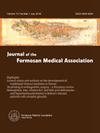Clinical outcomes and predictors in patients with acute on chronic liver failure in Southern Taiwan
IF 2.5
3区 医学
Q1 MEDICINE, GENERAL & INTERNAL
引用次数: 0
Abstract
Background/aims
The study is to analyze the clinical characteristics and identify prognostic factors as well as evaluate predictive models in patients with acute-on-chronic liver failure (ACLF) from Southern Taiwan.
Methods
The cohort study was conducted using the Chang Gung Research Database. We included patients with ACLF based on the definition provided by the Asian-Pacific Association for the Study of the Liver ACLF Research Consortium (AARC).
Results
A total of 231 patients diagnosed with ACLF were included in this study, out of which 26 patients underwent liver transplantation (LT). The primary cause of ACLF was acute exacerbation of hepatitis B virus (HBV) in 68.4% of cases and followed by severe alcoholic hepatitis (20.8%). Among LT-free patients, the 28-day mortality rate was observed to be 31%. Older age, higher INR and ammonia levels, and the presence of severe hepatic encephalopathy on 3–6 days of treatment were independent predictors of 28-day mortality. The CLIF-C ACLF and COSSH-ACLF scores, evaluated on 3–6 days, demonstrated the highest predictive performance for 28-day mortality. The optimal cut-off values for the CLIF-C ACLF and COSSH-ACLF scores were determined to be 47 and 6.3, respectively. Patients with CLIF-C ACLF score >63 or COSSH-ACLF score >8.1 experienced 100% mortality by day 28.
Conclusion
The CLIF-C ACLF and COSSH-ACLF scores, evaluated within one week after treatment, exhibit strong predictive capabilities for short-term mortality in ACLF patients. These models are valuable tools for guiding timely decision-making, including the consideration of liver transplantation or withdrawal from treatment.
台湾南部急性和慢性肝衰竭患者的临床结果和预测因素。
背景/目的本研究旨在分析南台湾急性慢性肝衰竭(ACLF)患者的临床特征,确定预后因素,并评估预测模型。结果本研究共纳入 231 名确诊为急性-慢性肝衰竭(ACLF)的患者,其中 26 名患者接受了肝移植手术(LT)。68.4%的 ACLF 患者的主要病因是乙型肝炎病毒(HBV)急性加重,其次是严重酒精性肝炎(20.8%)。在无LT的患者中,28天的死亡率为31%。年龄较大、INR 和氨水平较高以及治疗 3-6 天后出现严重肝性脑病是 28 天死亡率的独立预测因素。3-6 天评估的 CLIF-C ACLF 和 COSSH-ACLF 评分对 28 天死亡率的预测性能最高。CLIF-C ACLF 和 COSSH-ACLF 评分的最佳临界值分别为 47 和 6.3。结论治疗后一周内评估的 CLIF-C ACLF 和 COSSH-ACLF 评分对 ACLF 患者的短期死亡率具有很强的预测能力。这些模型是指导及时决策的重要工具,包括考虑肝移植或放弃治疗。
本文章由计算机程序翻译,如有差异,请以英文原文为准。
求助全文
约1分钟内获得全文
求助全文
来源期刊
CiteScore
6.50
自引率
6.20%
发文量
381
审稿时长
57 days
期刊介绍:
Journal of the Formosan Medical Association (JFMA), published continuously since 1902, is an open access international general medical journal of the Formosan Medical Association based in Taipei, Taiwan. It is indexed in Current Contents/ Clinical Medicine, Medline, ciSearch, CAB Abstracts, Embase, SIIC Data Bases, Research Alert, BIOSIS, Biological Abstracts, Scopus and ScienceDirect.
As a general medical journal, research related to clinical practice and research in all fields of medicine and related disciplines are considered for publication. Article types considered include perspectives, reviews, original papers, case reports, brief communications, correspondence and letters to the editor.

 求助内容:
求助内容: 应助结果提醒方式:
应助结果提醒方式:


